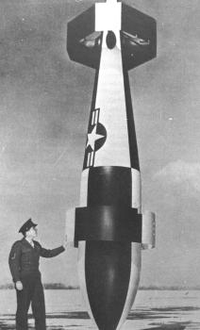JB-3 Tiamat
The JB-3 Tiamat, also designated MX-570, was an early air-to-air missile developed by Hughes Aircraft for the United States Army Air Forces during World War II. Regarded as a purely experimental vehicle, test launches took place for several years before the program was terminated.
| JB-3 | |
|---|---|
 | |
| Type | Air-to-air missile |
| Place of origin | United States |
| Service history | |
| In service | 1944-1947 |
| Used by | United States Army Air Forces |
| Production history | |
| Designed | 1944 |
| Manufacturer | Hughes Aircraft |
| Specifications | |
| Mass | 600 lb (270 kg) |
| Length | 14 ft 4 in (4.37 m) |
| Warhead | High explosive |
| Warhead weight | 500 pounds (230 kg) |
| Engine | Dual-thrust solid rocket motor Boost, 7,200 lbf (32 kN) for 3.5 sec Sustain, 200 lbf (0.89 kN) for 45 sec |
| Maximum speed | 600 miles per hour (970 km/h) |
Guidance system | Semi-active radar homing |
Launch platform | A-26 Invader |
| References | Ordway and Wakeford[1] |
Design and development
The Tiamat project began in January 1944, when a contract was awarded to Hughes Aircraft by the U.S. Army Air Forces (USAAF) for development of an experimental subsonic, solid-fueled air-to-air missile.[1] Developed in cooperation with the National Advisory Committee for Aeronautics (NACA), Tiamat was a large missile of vaguely dart-like shape and proportion, 14 feet 4 inches (4.37 m) in length and weighing 600 pounds (270 kg), with three large stabilizing and control fins at the aft end of the missile body. The rocket motor was a boost-sustain dual-thrust type, providing 7,200 lbf (32 kN) of thrust for 3.5 seconds, followed by 200 lbf (0.89 kN) for 45 seconds of cruising flight at 600 miles per hour (970 km/h).[1] Launched from an A-26 Invader light bomber,[1] Tiamat would use semi-active radar homing to track enemy aircraft,[2] and a proximity fuze was fitted for detonation of the missile's 500 lb (230 kg) warhead.[1]
Operational history
The first prototypes of Tiamat were designated MX-570, and were purely instrumented, ground-launched test vehicles launched by NACA at Wallops Island in Virginia to verify the design. MX-570 was slightly smaller than the definitive JB-3, being 11 feet (3.4 m) in length and weighing 625 pounds (283 kg) at launch. An additional rocket booster was fitted to provide for zero-length launch.[1] Launches of the MX-570 begin in late 1944, the first missiles to be launched at Wallops Island under the auspices of the Langley Research Center;[3] the first launch of the JB-3 proper took place on 6 August 1945.[4] Testing of both the MX-570 and JB-3 continued through 1947, when the program was terminated, definitive air-to-air missile products being underway.[2]
References
Citations
- Ordway and Wakeford 1960, p.186.
- Parsch 2005
- DeVincent-Hayes and Bennett 2001, p. 9.
- Fino 2017, p. 118.
Bibliography
- DeVincent-Hayes, Nan; Bowen Bennett (2001). Wallops Island. Images of America. Charleston, SC: Arcadia Publishing. ISBN 978-0-7385-0666-1.
- Fino, Steven A. (2017). Tiger Check: Automating the US Air Force Fighter Pilot in Air-to-Air Combat, 1950-1980. Baltimore, MD: Johns Hopkins University Press. ISBN 978-1-4214-232-7-2.
- Ordway, Frederick Ira; Ronald C. Wakeford (1960). International Missile and Spacecraft Guide. New York: McGraw-Hill. ASIN B000MAEGVC.
- Parsch, Andreas (27 January 2005). "JB Series". Directory of U.S. Military Rockets and Missiles, Appendix 1: Early Missiles and Drones. Designation-Systems. Retrieved 2017-12-17.
